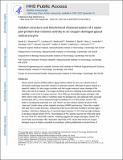| dc.contributor.author | Bowman, Sarah E. J. | |
| dc.contributor.author | Backman, Lindsey R. | |
| dc.contributor.author | Bjork, Rebekah E. | |
| dc.contributor.author | Andorfer, Mary | |
| dc.contributor.author | Yori, Santiago | |
| dc.contributor.author | Caruso, Alessio | |
| dc.contributor.author | Stultz, Collin M | |
| dc.contributor.author | Drennan, Catherine L | |
| dc.date.accessioned | 2021-02-23T23:00:04Z | |
| dc.date.available | 2021-02-23T23:00:04Z | |
| dc.date.issued | 2019-06 | |
| dc.identifier.issn | 0949-8257 | |
| dc.identifier.issn | 1432-1327 | |
| dc.identifier.uri | https://hdl.handle.net/1721.1/129986 | |
| dc.description.abstract | Abstract: Glycyl radical enzymes (GREs) utilize a glycyl radical cofactor to carry out a diverse array of chemically challenging enzymatic reactions in anaerobic bacteria. Although the glycyl radical is a powerful catalyst, it is also oxygen sensitive such that oxygen exposure causes cleavage of the GRE at the site of the radical. This oxygen sensitivity presents a challenge to facultative anaerobes dwelling in areas prone to oxygen exposure. Once GREs are irreversibly oxygen damaged, cells either need to make new GREs or somehow repair the damaged one. One particular GRE, pyruvate formate lyase (PFL), can be repaired through the binding of a 14.3 kDa protein, termed YfiD, which is constitutively expressed in E. coli. Herein, we have solved a solution structure of this ‘spare part’ protein using nuclear magnetic resonance spectroscopy. These data, coupled with data from circular dichroism, indicate that YfiD has an inherently flexible N-terminal region (residues 1–60) that is followed by a C-terminal region (residues 72–127) that has high similarity to the glycyl radical domain of PFL. Reconstitution of PFL activity requires that YfiD binds within the core of the PFL barrel fold; however, modeling suggests that oxygen-damaged, i.e. cleaved, PFL cannot fully accommodate YfiD. We further report that a PFL variant that mimics the oxygen-damaged enzyme is highly susceptible to proteolysis, yielding additionally truncated forms of PFL. One such PFL variant of ~ 77 kDa makes an ideal scaffold for the accommodation of YfiD. A molecular model for the rescue of PFL activity by YfiD is presented. | en_US |
| dc.description.sponsorship | National Institutes of Health (Grants R01GM069857, R35GM126982, R56AR044276, F32GM129882) | en_US |
| dc.description.sponsorship | National Science Foundation (NSF) (Grant 1122374) | en_US |
| dc.language.iso | en | |
| dc.publisher | Springer Science and Business Media LLC | en_US |
| dc.relation.isversionof | http://dx.doi.org/10.1007/s00775-019-01681-2 | en_US |
| dc.rights | Creative Commons Attribution-Noncommercial-Share Alike | en_US |
| dc.rights.uri | http://creativecommons.org/licenses/by-nc-sa/4.0/ | en_US |
| dc.source | PMC | en_US |
| dc.title | Solution structure and biochemical characterization of a spare part protein that restores activity to an oxygen-damaged glycyl radical enzyme | en_US |
| dc.type | Article | en_US |
| dc.identifier.citation | Bowman, Sarah E. J. et al. "Solution structure and biochemical characterization of a spare part protein that restores activity to an oxygen-damaged glycyl radical enzyme." Journal of Biological Inorganic Chemistry 24, 6 (June 2019): 817–829 © 2019 Society for Biological Inorganic Chemistry | en_US |
| dc.contributor.department | Massachusetts Institute of Technology. Department of Chemistry | en_US |
| dc.contributor.department | Massachusetts Institute of Technology. Department of Biology | en_US |
| dc.contributor.department | Massachusetts Institute of Technology. Department of Electrical Engineering and Computer Science | en_US |
| dc.contributor.department | Massachusetts Institute of Technology. Institute for Medical Engineering & Science | en_US |
| dc.relation.journal | Journal of Biological Inorganic Chemistry | en_US |
| dc.eprint.version | Author's final manuscript | en_US |
| dc.type.uri | http://purl.org/eprint/type/JournalArticle | en_US |
| eprint.status | http://purl.org/eprint/status/PeerReviewed | en_US |
| dc.date.updated | 2020-09-18T18:30:12Z | |
| dspace.date.submission | 2020-09-18T18:30:14Z | |
| mit.journal.volume | 24 | en_US |
| mit.journal.issue | 6 | en_US |
| mit.license | OPEN_ACCESS_POLICY | |
| mit.metadata.status | Complete | |
